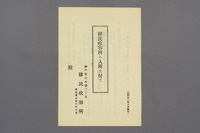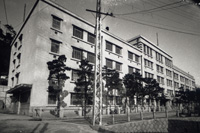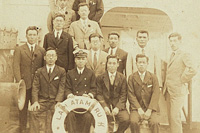National Kobe Emigrant Camp (Kobe Emigration Center)
"March 8, 1930. It is raining at the Port of Kobe. A spring rain that leaves a fine mist… The red clay soil slope on the way from Sannomiya Station to Yamanote has turned into a mud pool. A large yellow building, devoid of ornamentation, stands where the path comes to a dead end against a hill… This is the 'National Emigrant Cape'"(Tatsuzo Ishikawa, Sobo. Kaizosha, 1935). The novel "Sobo" written by Tatsuzo Ishikawa who won the first Akutagawa Prize for it, begins with this paragraph, as if it foreshadowed a dayly life at the Emigrant Camp starting from then and even a life in a country of dreams, Brazil.
Based on the Government's policy of encouraging emigration, the "National Kobe Emigrant Camp" was built on a hill (the present address: 3-19-8 Yamamoto Street, Chuo-ku, Kobe City) in March 1928, exactly twenty years after the sailing of the ship Kasato-maru. It is reported that the construction of the Emigrant Camp made financial conditions of inns for emigrants around the Meriken wharf worsen, and some of those inns discharged their employees owing to a decline in the number of customers ("Kobe Matashin Shimpo", March 5, 1928). It is said that on the opening day, March 10, emigration companies arraged for cars and picking up emigrants staying at those inns, took them to the new Emigrant Camp. The first set of emigrants in the Emigrant Camp consisting of 581 persons was accommodated in the Camp. Its stay limit was ten days. The emigrants spent time in attending various kinds of lectures and having vaccinations every day until their departure. Lodging expenses were free of charge. In the "Kobe Yushin Nippo" a special series of articles reporting on emigrants’ daily life in the Camp entitled "One Week in the National Emigrant Camp" was published on March 13-19. Before the setting sail of the ship Hawai-maru, on March 17, the emigrants gave three "banzai" cheers and walked in procession down the slope called the "Emigration Slope", to a wharf . "Emigrants, wearing strange western clothes, formed a long line and started noisily on a trip to Brazil filled with coffee flavors to look for opportunities to succeed in life there"(Nippo, March 19, 1928)was a headline of a Kobe Yushin Nippo article reporting the setting sail.
The "National Kobe Emigrant Camp" was renamed the "Kobe Emigrant Education Center" in 1932. It was closed during the war, and its facilities were used, as the "Greater East Asia Personnel Training Center" for training military civilian employees sent to the occupied territories, until the end of the war. After the war, with the resumption of emigration projects, the facilities were reopened in 1952 as the "Kobe Emigration Mediation Center") (under the Ministry of Foreign Affairs). After the "Yokohama Emigration Mediation Center" was established (under the Ministry of Foreign Affairs) in 1956, the number of emigrants departing from Yokohama which was the last port of departure increased. In 1964 the facilities were again renamed the "Kobe Emigration Center", but with a decrease in the number of overseas emigrants, they were closed on May 31, 1971 and finished their mission over a period of more than 40 years except for a period of interruption.
Terrible specacles that cities destroyed by the Great Hanshin-Awaji Earthquake in January 1995 presented also greatly shocked Japanese Brazilians. It is said, however, that many Japanese Brazilians rediscovered their roots in the building of the "National Kobe Emigrant House" which remained intact amid the rubble. Life of Emigrants to Brazil started here. In front of the entrance to the Emigrant House the "birthplace of Japanese emigration to Brazil" monument was built. It might not be accidental in history that with the occurrence of Great Hanshin-Awaji Earthquke, a project honoring the emigrants who departted from Kobe was promoted. The "Monument in memory of emigrants boarding ships at the Port of Kobe" was built in Meriken Park, and the "Emigration Slope" which emigrants used to walk down was also restored to good condition. In 2007 a pending project for the preserve and restoration of the "National Kobe Emigrant Camp" was determined. The building is planned to be reopened as the "Kaigai Nikkeijin Kaikan (Overseas People of Japanese descent Hall)" (provisional name) in late May 2009 that has functions of an emigration museum, support for foreign residents and international artist fellowship, which is suitable for the history of the Camp.
The "National Kobe Emigrant Camp" building, saw off approximately 250,000 emigrants and survived the Great Hanshin Earthquake. The building is still watching over the Streets and Port of Kobe as if it were a living witness to not only history of emigration but modern history of Kobe.
-
 Emigrant Camp information pamphlet
Emigrant Camp information pamphlet -
 Emigrant Camp (1)
Emigrant Camp (1) -
 Emigrant Camp (2)
Emigrant Camp (2) -
Articles in newspapers / magazines
-
 Tatsuzo Ishikawa aboard the ship Rapurata-maru (photo taken on April 29, 1930)
Tatsuzo Ishikawa aboard the ship Rapurata-maru (photo taken on April 29, 1930)











